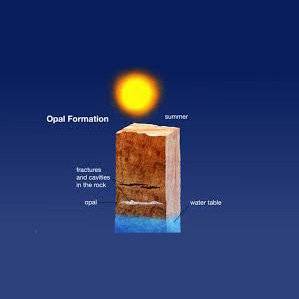How is Opal Formed? - the Geology of Opal

Geological factors linked with the formation of opal are still being researched and are subjects of active discussion among geologists, miners and opal prospectors.
There are three primary models for the formation of opals and although they are independent of each other, a link may exist among them.
Weathering Model
A majority of the opals recovered from opal fields in Lightening Ridge are found close to the top of many Finch clay facies lenses just underneath the overlying part of Wallangulla Sandstone Member. When these opal fields are geologically mapped, it is seen that the thickest sandstone is found in areas with the largest concentration of opal. The gemstone is rarely found in places where sandstone is scarce.
This data concurs with the view that weathered sandstone is the silica source for opal formation. The finding of opal in upper reaches of Finch clay facies is in accordance with a concept of siliceous solutions (a ground water and silica mix) percolated down from Wallangulla Sandstone Member (the source rock) by impervious barrier of clay fades or opal dirt.
Additional factors for opal formation involve:
- The alteration from alkaline to acidic environment
- Presence of ferric oxide, magnesium oxide or aluminum oxide
- sodium sulphate or sodium chloride being present
Syntectonic Model
This geographical model forwards the view that the opal created from the mineral enriched waters rising to the land surface under substantial pressure through breccia and fault pipes. Tectonic and large scale geological processes forced water hydraulically into faults and fractures. After the water is dissipated into lower pressure areas, opal gets deposited as the veins.
The basic concepts linked with syntectonic model are;
- Development of opal occurred post rock formation where it is available.
- The gemstone was formed comparatively swiftly
- Blows and faults are prerequisites for opal formation in a particular area.
Microbe Model
The claystone containing opal normally contains significant quantities of organic matter which were fossilized thousands of years ago. Many categories of aerobic bacteria along with microbe fossils have been marked with opal samples from Lightning Ridge immediate area.
When the deposition of cretaceous sediments, a luxury of smectite clay and organic matter inside a few sediments offered an ideal ecology for microbe breeding. Enzymes and waste acids excreted by microbes resulted in weathering of feldspars and clay minerals by chemical means in rocks. The ultimate result of feeding and then production of waste resulted in favorable conditions for opal formation.


